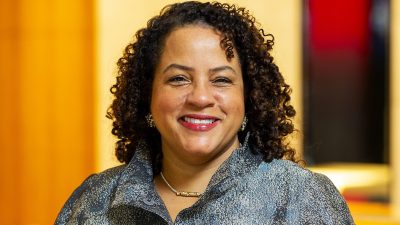
In March, the Alliance released my major pandemic project: The AAM Strategic Foresight Toolkit, a comprehensive guide to applying the skills of futures thinking to museum practice. Over 300 people have purchased the Toolkit, and I have been thrilled to track its impact in the museum universe. Some folks are using the text, exercises and games for professional development, others are integrating the tools into projects and teams. Today on the blog, Ann Fortescue tells us how staff and board of the International Museum of Art & Science in McAllen, TX are using toolkit resources to guide their strategic planning.
–Elizabeth Merritt, VP Strategic Foresight and Founding Director, Center for the Future of Museums, American Alliance of Museums.
When the board of trustees and leadership team of the International Museum of Art and Science (IMAS) met for our annual meeting last year, we found ourselves navigating a highly disrupted landscape. In addition to the COVID-19 pandemic, we had just endured an epic failure of the Texas electrical grid and a hurricane the summer before. These events—all foreseeable yet impossible to predict in detail—made it clear that our plans had to be designed for success in multiple potential futures.
For that reason, we decided to focus our meeting around the 2021 TrendsWatch chapter on strategic foresight. In the first of four sessions, Elizabeth Merritt, Vice President of Strategic Foresight and Founding Director of the Center for the Future of Museums at the American Alliance of Museums, guided us through an introduction to foresight planning. At the following three, I adapted exercises from AAM’s Strategic Foresight Toolkit to introduce key foresight practices: scanning, scenario planning, implications, and backcasting. I personalized each exercise with examples specific to IMAS to make the information more relatable for the trustees and staff leadership team.
In the year since, we have been focused on developing our new strategic institutional plan. We initially began working on it in fall 2019, using some of the organizing elements of our existing but outdated plan to kick off the process. Because the museum had changed significantly since that plan was created in 2017, we already knew we needed a fresh start. Then the pandemic arrived, and we put our work on hold for a year as we focused on survival in the present. With vaccines on the horizon in early 2021, trustees and staff gradually resumed planning activities, albeit with some reservations about the durability of a plan given the pandemic hardships and disruptions we’d just endured.
After our time studying strategic foresight, I began to notice some changes with our board and leadership. We had begun expressing uncertainty with more confidence and less anxiety, and had a newfound comfort with the unexpected and ability to anticipate “what if.” Since data from the past year was unusable for projections because of COVID-era abnormalities, we leaned on strategic foresight practices instead. For example, our leadership team applied elements of backcasting and scenario planning to updating our disaster preparedness/emergency response plan, which now allows for greater flexibility in response actions, procedures, and preparedness. (When we asked the City of McAllen’s Emergency Preparedness Director to review the new plan, he responded with a glowing letter of commendation.)
For our exhibit planning, we used current data and futurist thinking on societal needs to develop a strategy to positively impact them. Our new plan emphasizes interactives for two or more people where cooperation or interaction occurs. This shift is in response to the pandemic-accelerated alarms about screen time for children and the growing concerns about diminishing in-person social interactions, especially among children and teens, as we rely more on virtual communications. We used current data, trends, and projections to anticipate a growing need for more cooperative, creative, in-person activities that museums like IMAS are ideally suited to provide.
As we proceeded with strategic planning, we began working with staff to identify department-level goals, which was a slower process than usual because of the increased audience demand and reduced staffing we were dealing with at the time. Eventually, these department-level goals coalesced into three museum-wide ones: engage learners of all ages, involve the community, and create exceptional museum experiences.
Our new plan represents a fundamental organizational shift to focusing on the impact of our work with our audiences and staff. This shift is significantly influenced by the staff’s involvement in two virtual professional development programs, Cultural Competence Learning Institute (CCLI) and Cambio. Both are designed as catalysts: Cambio helps museums focus on “long-term, transformational change” and CCLI “embrac[es] organizational change to meaningfully connect with new and diverse audiences.”
The staff had never experienced year-long, participatory, applied learning programs, and we still struggle with some of the new concepts we learned, like taking risks, making changes, sharing authority, and asking difficult questions. In the meantime, the programs helped us see that we’re already really good at building relationships and valuing cultural identity, strengths we proudly lean into now. CCLI and Cambio have changed our vocabulary by creating a common language for us to continue learning as we converse candidly with partners, share ideas as equals, and invite leadership from all levels of the organization.
Like CCLI and Cambio, AAM’s Strategic Foresight Toolkit introduced us to new ways of thinking about our future and using data, and it changed the way we plan. The implementation tactics for the new IMAS strategic plan are more fluid and less prescriptive than the last plan. Having learned during the pandemic that staff excel in areas outside their immediate responsibilities, for instance, we embedded collaborative accountability in the plan to allow for shared responsibility and encourage more work between departments and between staff and board. At next year’s annual meeting, trustees and leadership staff will use the implications and backcasting tools to examine and reinvigorate the standing committees of the board to embrace the new plan in partnership with the staff and community, and we’ll include the whole staff in this work through our Idea Board and all-staff meetings.
The tools we’ve acquired over the past two years are still new, and we’re not always skillful or accurate when we employ them, but with use, we’ll experiment and modify them to suit the tasks at hand and anticipate scenarios in the future.
Ann Fortescue is President & Executive Director of the International Museum of Art & Science in McAllen, TX, and served on the AAM Accreditation Commission from 2015 to 2018.
You can follow the work of IMAS on Facebook as imasmcallen and on Instagram, Twitter, and as imasmuseum
https://www.facebook.com/imasmcallen
https://www.instagram.com/imasmuseum/
https://twitter.com/imasmuseum
https://www.youtube.com/user/imasmuseum
Skip over related stories to continue reading article









Comments